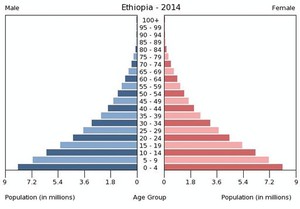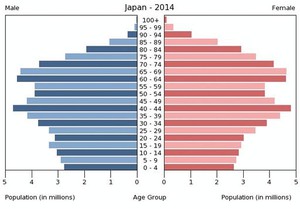Population composition and characteristics
Population composition is the description of the characteristics of a group of people in terms of factors such as their age, sex, marital status, education, occupation, and relationship to the head of household. Of these, the age and sex composition of any population are most widely used. The number and proportion of males and females in each age group have considerable impact on the population’s current and future social and economic situation.
Age
The age structure of a population is one of the basic demographic characteristics and is helpful for demographic analysis and for socio-economic development planning. Generally, less developed countries have young populations, while more developed countries have old or ageing populations (Population Reference Bureau, 2011). The relative numbers of different age groups have a significant impact on social and economic policies and on the way people live their lives.
The age dependency ratio is the ratio of the number of people in dependent age groups compared to the economically productive age groups. Dependent age groups are the young (aged under 15) and the old (over 65). People aged from 15 to 64 are classed as economically productive. The age dependency ratio is often used as an indicator of the economic burden of the countries. In countries with high age dependency ratios there is a large number of elderly and young people who are dependent on the economic productivity of the people in the middle age group. The large proportion of children in the population means countries with very high birth rates have the highest age dependency ratios.
Sex ratio
The sex ratio is the ratio of males to females in a given population, usually expressed as the number of males for every 100 females. Sex ratios may vary due to different patterns of death and migration for males and females within the population. For example, males are more vulnerable to wars and more likely to be mobile and migrate to other regions or countries, which would affect the sex ratio within the population, especially for young adult males.
Population pyramid
Both key variables of age and sex are combined in the population pyramid. A population pyramid is a graph which displays a population’s age and sex composition. The numbers or proportions of males and females in each five-year age group are represented using horizontal bars. Population pyramids of countries can differ markedly as a result of past and current patterns of birth rates, death rates and migration.
Figure 2.6(a) shows the population pyramid for Ethiopia and, for comparison, Figure 2.6(b) gives the data for Japan. The shape of the Ethiopian pyramid shows that there is a high birth rate and many more young people than old. The pyramid for Japan shows an ageing population with the majority of the people aged between about 30 and 70. There are also significant numbers of people, especially women, over 90 in Japan, indicating longer life expectancy.

Figure 2.6(a) Population pyramid of Ethiopia, 2014.

Figure 2.6(b) Population pyramid of Japan, 2014.
Look at Figure 2.6(a) and (b) and consider the three age groups used to calculate the age dependency ratio. How would the differences in the two pyramids affect the age dependency ratios for Ethiopia and Japan? (Hint: You do not have to calculate the ratio, just describe the differences.)
In Ethiopia there are many more people aged under 15 compared to the economically productive group, but few aged over 65. In Japan, there are more in the middle, productive, age group and a smaller proportion of children but also many more dependent older people. If this trend continues, in a few decades’ time there will be an even greater proportion of dependent elderly people in Japan compared to the economically productive middle group.